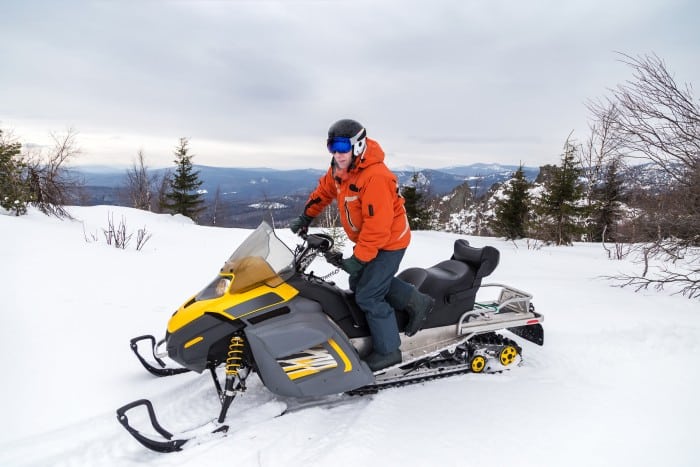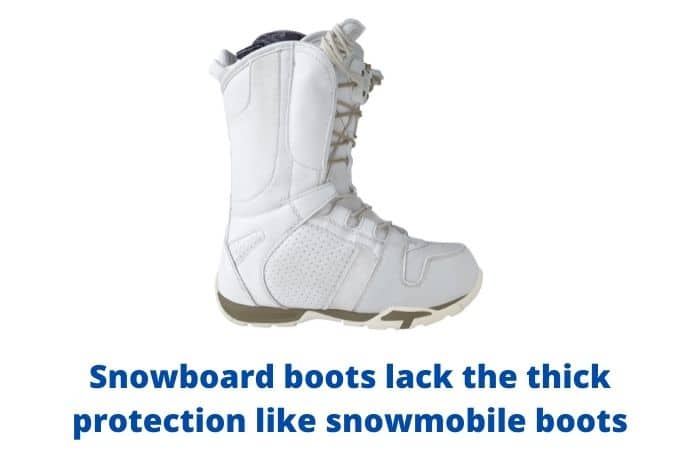If you enjoy snowmobiling out to untouched snow in the backcountry, you may wonder if it’s a good idea to wear snowboard boots while on your snowmobile. While this may save some time, it is important to understand that different sports have different gear that has been customized to perform different functions.
Snowboard boots can be worn on a snowmobile, and many people do, especially if they’re snowmobiling to snowboard somewhere that isn’t accessible by lift. However, snowboard boots aren’t aggressive enough to handle fast snowmobile rides. So, if you’re only going snowmobiling, wear snowmobile boots.
There are several reasons why both sports boots are customized and designed differently, with a few similarities. Having the proper boots gives you complete control over your sport while keeping you warm and comfortable.
Can You Snowmobile Using Snowboarding Boots?
Boots for snow sports are expensive and bulky, so it makes sense to only want to have one pair. But is it a good idea to wear your snowboarding boots while sledding?
You can ride your snowmobile in snowboarding boots, but you might end up in the market for a new pair of boots. Snowboard boots lack the reinforcement in the ankle that snowmobile boots have, and their lack of rigidness makes them vulnerable to wear and tear from the elements faced when snowboarding.
On the other hand, snowmobile boots’ rigid design provides comfort during long rides, preventing weariness on your feet.
You can use your snowboarding boots to snowmobile, but still, you will experience and feel some differences.
If there is no good reason for wearing snowboard boots on a snowmobile, then don’t.

Boots Functionality
The most important pair of boots are those that keep you warm in the snow and ice. Both boots are made to keep your feet warm and comfortable.
However, snowmobile boots are more aggressively designed than snowboard boots.
Snowmobile boots are more snow-resistant, particularly in terms of waterproofing and insulation.
A good pair of snowmobile boots should have a rubber, waterproof bottom with a good lug sole for traction and a synthetic upper to repel snow.
Snowmobile boots are designed to provide comfort and keep you warm and are made with durable materials to handle extreme weather conditions.
Snowmobile boots ensure your feet stay warm and dry in severe conditions and during fast rides as you run against the wind.
Snowboarding boots work with your snowboard to help you have complete control of your ride while keeping your feet warm in any weather condition.
They have an adjustable lacing system to fit the boot well and support your feet and ankles during high-speed turns.
Snowboarding and snowmobile boots have few design aspects that differentiate one pair of boots from the other, making them less practical to interchange between the sports.
Effects of Using Snowboard Boots on Snowmobiles
Riding a snowmobile in snowboarding boots can cause bruises on your calves and legs, especially if the laces are tight around your calf, ankles, or upper feet, also known as the pressure points.
The injuries are also due to the flex design of the snowboard boots around the calves and the ankles.
When riding a snowmobile, your feet slightly bend at the ankle joints, and if the boot can flex, this places pressure on the joints causing bruises.
Snowmobile boots have a rigid outer shell that helps minimize weariness and protects your feet, reducing the risk of injury, which snowboard boots don’t have.
Snowboard boots lack the thick reinforcement protection of snowmobile boots that help withstand the fast rides of a snowmobile, which can damage your snowboard boots.
The aggressive riding that comes with snowmobiling calls for much more aggressive boots than snowboarding.
If you decide to wear snowmobiling snowboard boots, be prepared for them to break down quickly, especially the soles.
Additionally, if you’re planning a long day out on your snowmobile, you’re better off in snowmobile boots as they are more insulated and water-resistant than snowboard boots.
Wearing your snowboard boots will likely become wet, meaning you will have some very cold feet by the end of the day.
What Are the Differences Between Snowboarding and Snowmobile Boots?
The characteristics of snowboarding and snowmobile boots distinguish them from their intended use. The following are detailed differences in features and purpose:
1. The Outer Shell
Snowboard boots have a softer outer shell that flexes as you snowboard.
The outer shell is made of synthetic fabrics and leather that add to the boot flex, allowing a flexible motion to turn while also providing ankle support.
Although snowboard boots are made to be worn on the mountain all day, the outer shell isn’t completely waterproof, and they may become damp after a few hours on the hill.
In contrast, snowmobile boots have a rigid outer shell made of durable leather and treated textiles that make them long-lasting.
Snowmobile boots are designed to keep you warm and protected from snow, rain, and ice, with a more rigid outer shell to handle fast-paced riding and other obstacles such as trees and hard-packed snow.
2. Padding and Boot Coverage
Snowboard boots are designed to manage and control many forces involved in the sport, such as turning, jumping, and stopping.
To protect the rider performing these maneuvers, they are padded around the entirety of the boot.
The boots’ flexibility is based on the terrain the snowboarder enjoys riding, with some boots being quite soft for optimum maneuverability.
Snowmobiles come in different types that handle different terrain and snow conditions.
The toes and heels of snowmobiling boots come with extra cushioning and kick plates on the toe of the boot to protect your feet from outside impacts.
The kick plates are thick rubber wraps that extend from the boot’s sole, covering the toe cap.
They resist wear and tear and allow you to clear snow or ice from your snowmobile.
Snowboard boots lack the thick protection of snowmobile boots needed to withstand the elements faced when riding a snowmobile, all of which can damage your snowboard boots.

3. Waterproof Protection
There is a difference in waterproofing between snowboarding and snowmobiling boots.
Snowmobile boots are heavily waterproof and water repellent, keeping your feet dry and comfortable during riding.
Waterproof, breathable materials prevent any outside moisture from entering your boots and keep your feet dry by removing excess sweat from your feet that may build up during riding.
On the other hand, most snowboard boots aren’t waterproof enough or lack 100% waterproofing and will get wet from snow, water, and sweat.
4. Soles and Treads
There is also a difference in the soles and treads of snowboarding and snowmobiling boots.
As snowboard boots are always bound to the board through the use of bindings, the design of their soles is reasonably basic.
Therefore, they lack aggressive soles and treads, making them unsuitable for snowmobile use, as the sole doesn’t provide a firm grip on the snow.
On the other hand, snowmobile boots have high-quality rubber soles with a sturdy appearance and feel to provide a firm grip on the snowmobile, even when covered in snow or ice.
The soles have aggressive void tread patterns, which offer better snow traction and are designed to withstand severe snow and ice conditions during winter.
Snowmobile boots have a deep tread pattern that provides a firm grip, allowing riders to stay on their two feet on the snowmobile or snow.
The depth of the lugs, or the channels and bumps on the rubber or outer sole, can indicate your boot’s traction.
Choose snowmobile boots with small rubber protrusions along the edges to prevent slips and aid in ice and snow traction.
5. Insulation
Cold feet can easily ruin your time in the snow. You can ride longer when your feet are warm and free from the cold weather.
Both the boots are built with insulating materials that keep you warm during a day on the mountain.
However, the insulation of snowboard boots is much lower than snowmobiling boots, so you’d be better off with snowmobile boots, particularly if you get cold feet quickly.
Snowmobile boots are heavily fitted with insulating materials to keep your feet warm in severe conditions, meaning you can spend more time riding around the mountain.
Unlike snowboard boots, snowmobile boots have a seven-layer, insulated inner boot system that keeps your feet warm to -40 degrees Celsius.
It is recommended that snowmobile boots have more than 600 grams of insulation.
Snowmobile boots insulated with 600 grams of Thinsulate keep your feet warm in extreme weather or freezing temperatures and protect your feet even at higher activity levels than 400 grams.
They also keep moisture and cold out of your boots as you ride through the mountains.
6. Height
The height of snowboarding and snowmobiling boots also differs to suit the function of each sport.
It is recommended that snowboard boots sit around the middle of your calf. However, this depends on the size of your leg.
This gives your calves the extra support to take on all the turns and jumps while protecting them from the elements.
With snowmobiling boots, the higher your boots are, the more protection you get from the snow.
Snowmobile boots come in different shaft styles; some have high shafts, while others look like hiking boots.
If you want your ankles to be warm and protected from the elements, it is advisable to go for a taller shaft.
What To Look For When Choosing Snowmobiling Boots?
If you’re looking to purchase a pair of snowmobiling boots, you should consider a few specific factors.
1. Precise Lacing Systems
A good lacing system should provide enough adjustability to the boots, allowing you to apply the right amount of pressure to the ankle and lower calf.
Snowmobile boots have three lacing systems: traditional laces, quick-pull, and boa.
An elaborate lacing system, such as the boa, will provide a precise fit with ease as you can make adjustments while wearing gloves with just one hand.
A good lacing system on your snowmobile boots is an essential aspect of snowmobiling, as it locks your feet and ankles in place for a responsive and comfortable ride.
They also help you ride longer, as you don’t have to stop and make regular adjustments, reducing interruptions.
2. Thermal Enhanced Boots Liners and Cozy Footbeds
Footbeds and liners contribute to your overall comfort inside the boots.
Snowmobile boots liners are insulated to provide warmth to your feet and are heavily cushioned for comfort.
The liners of some of the boots are removable and can be swapped out or altered for a precise fit.
Removable liners make keeping your boots dry and ready for the next ride a breeze. Your boots may become damp as a result of your feet’ sweat.
Therefore, removable liners make it easier to wash and dry first compared to non-removable liners.
After each day, remember to take them out of your boots to allow them to dry. The insole of the boot is made up of footbeds.
Your boot footbeds should fit the natural foot shape for optimal comfort.
When riding on a snowmobile, if the footbed is too small or too large, it will cause pain in the feet and ankles.
Snowmobiling requires you to be completely comfortable inside your boots, and the boots, footbeds, and liners help to increase the comfort of your feet and keep you warm so you can ride for long hours without your feet getting cold or wearing out.

3. Boots Comfort and Proper Fit
Snowmobiling on fresh and dry feet is ideal for maximizing your time on the mountain.
Snowmobile boots should perfectly fit you, to avoid the cold and provide warmth, comfort, and protection.
A well-fitting boot should allow you to stretch your toes freely without feeling constrained.
When wearing your boots, your bigger toe should be in contact with the front of the boot.
They should have adequate room for your feet’s warmth to circulate freely but not so loose that your feet can move freely.
Tight or narrow boots may cause ankle, heel, or toe pinches. The boots are too tight if you feel your toes or the side of your feet are squashed.
Your foot instep should comfortably sit on the boot’s footbed, and your heel hold should be snug enough to avoid lifting inside your boots.
The boots go hand in hand with socks. When choosing the perfect pair of socks for your boots, select socks that allow breathing and moisture to pass through easily.
Your socks should be thin and smooth-faced to allow good breathing and moisture movement in and out of the boot.
Riding your snowmobile with bulky socks can make your feet sore.
For snowmobile boots, it is advisable to wear socks made of breathable materials and synthetic blends, such as nylon, polypropylene, fleece, wool, or silk.
They absorb moisture readily and are easy to clean and dry quickly. The socks also help to keep you warm and dry.
Final Thoughts
Snowboard boots can be worn on a snowmobile but are less comfortable than snowmobile boots.
The boots have differences and more minor similarities that make them less interchangeable between the two sports.
The outer shell of the snowboard boot is less rigid to support different snowboarding styles.
Snowboard boots are not as well insulated as snowmobile boots, which have 400 grams of insulation or more.
When riding a snowmobile, flexing your snowboard boots puts pressure on your ankles and calves, which can result in injury.
As a result, each boot should be used for its intended purpose.
